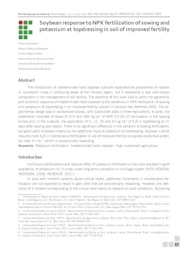Soybean response to NPK fertilization of sowing and potassium at topdressing in soil of improved fertility.
Soybean response to NPK fertilization of sowing and potassium at topdressing in soil of improved fertility.
Author(s): HICKMANN, C.; RESENDE, A. V. de; SILVA, C. A.; LACERDA, J. J. de J.; FURTINI NETO, A. E.; MOREIRA, S. G.
Summary: The introduction of indeterminate habit soybean cultivars expanded the possibilities of rotation or succession crops in producing areas of the Cerrado region, but it represents a less well-known component in the management of soil fertility. The objective of this work was to verify the agronomic and economic response of indeterminate habit soybean to the variations in NPK fertilization of sowing and potassium at topdressing in an improved fertility Latosol in Campos das Vertentes (MG). The experimental design was in randomized blocks, with subdivided plots in three replications. In plots, the treatments consisted of doses of 315 and 485 kg ha-1 of NPK 02-30-10 formulation in the sowing furrow and, in the subplots, the application of 0, 15, 30 and 45 kg ha-1 of K2O in topdressing at 21 days after sowing was tested. There is no significant difference in the variation of sowing fertilization, but grain yield increases linearly by the additional input of potassium at topdressing. Soybean cultivar requires more K2O in maintenance fertilization in soil of improved fertility to express productive potential near 4 t ha-1, which is economically rewarding.
Publication year: 2017
Types of publication: Journal article
Unit: Embrapa Maize & Sorghum
Keywords: Adubação, Fertilidade do solo, Fertilização, Potássio
Observation
Some of Embrapa's publications are published as ePub files. To read them, use or download one of the following free software options to your computer or mobile device. Android: Google Play Books; IOS: iBooks; Windows and Linux: Calibre.
Access other publications
Access the Agricultural Research Database (BDPA) to consult Embrapa's full library collection and records.
Visit Embrapa Bookstore to purchase books and other publications sold by Embrapa.

